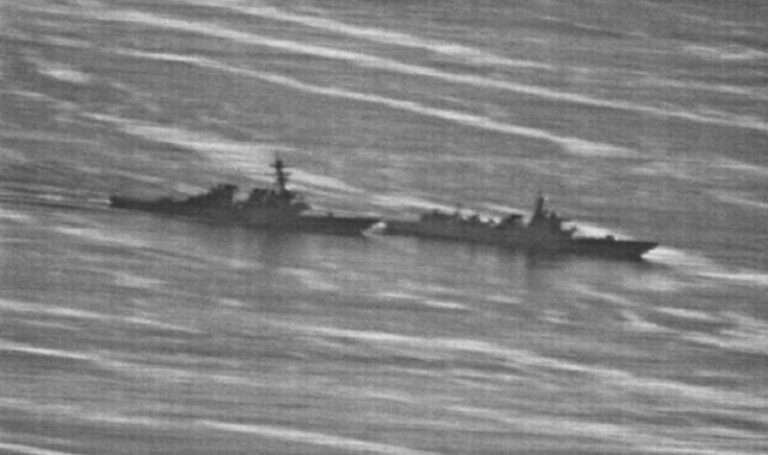
This article was originally published by Radio Free Asia and is reprinted with permission.
China is upgrading two of its civilian South China Sea supply ships with new high-tech surveillance equipment to help the vessels track ships from the United States, Vietnam, and other foreign countries, new Chinese government procurement documents show.
This is just the latest instance of the Chinese government leveraging civilian assets to pursue its national security interests in the South China Sea, a common practice under China’s strategy of “military-civil fusion.”
The contract for this project was awarded Thursday to Zhejiang Dali Science and Technology Co., Ltd. by Sansha City, which is responsible for administering China’s maritime and territorial claims in the contested South China Sea.
Dali, which appears to also work with the Chinese military, is set to provide a pair of its “DLS-16T Long-Distance Optoelectronic Monitoring Systems” for use on the city’s two main supply ships — the Sansha 1 and Sansha 2 — for 3,830,000 yuan ($547,000).
Multi-function supply ships
The Sansha 1 and Sansha 2 are mainly tasked with supplying Woody Island, which is China’s largest base in the Paracels and serves as the headquarters for Sansha City. Though the Paracels are claimed by Vietnam, China, and Taiwan, only the PRC occupies any features in the archipelago.
But both vessels have also ventured down further south to the Spratlys, where China is locked in maritime and territorial disputes with Vietnam, the Philippines, Malaysia, Taiwan, and Brunei.
The Sansha 1 came into service in January 2015 and the Sansha 2 completed its maiden voyage in August 2019. This allowed the city’s older Qiongsha 3 supply ship to focus on supplying China’s settlements in the Crescent Group in the Paracels, state-run Hainan Daily reported.
State-owned CSSC Guangzhou Shipyard International, which built the Sansha 2, said that the 128-meter-long vessel would integrate “transportation and supply, administrative jurisdiction, emergency rescue command, emergency medical assistance, and island and reef scientific survey capabilities.”
The company also stated that the Sansha 2 would “play an important role in defending the motherland’s southern gate” — which is how China sometimes refers to its claimed territory in the disputed South China Sea.
Defending the motherland’s southern gate
Once they are outfitted with their new surveillance equipment, the Sansha 1 and Sansha 2 will be able to play an even greater role in asserting China’s claims.
According to bidding documents reviewed by RFA, the DLS-16T Long-Distance Optoelectronic Monitoring Systems from Dali are intended to allow the supply ships to “carry out omnidirectional search, observation, surveillance, and video evidence collection against maritime and aerial targets” such as ships, overboard people, objects floating in the sea, and aircraft under all weather conditions, 24 hours a day.
Sansha City was seeking a tracking system that would integrate visible light imaging, infrared thermal imaging, automatic target tracking, radar, fog penetration, image enhancement, the U.S.-run satellite navigation system GPS, the Chinese equivalent system BeiDou, and other capabilities, the bidding documents show.
The software system for the tracking equipment is to be used to detect, identify, and track “sensitive ships” from countries like the United States, Japan, the Philippines, Vietnam, Indonesia, and Taiwan, as well as record and display this information in real-time, the documents say.
Corporate documents from Dali indicate that the company works closely with state-owned Chinese defense contractors and the People’s Liberation Army (PLA).
Dali will be obligated to complete its work on the Sansha 1 and Sansha 2 within three months of signing its contract with Sansha City, the bidding documents say.
Military-civil fusion
China has a long track record of utilizing civilian ships like the Sansha 1 and Sansha 2 to assert control over the South China Sea.
Devin Thorne, a Washington D.C.-based analyst, told RFA that “there are a few ways that China’s civilian fleets contribute to national security as part of military-civil fusion,” referencing China’s strategy of synthesizing resources to simultaneously advance both defense and development goals.
“They help assert China’s maritime rights by simply being active in disputed areas, they facilitate military power projection, and they extend Beijing’s eyes and ears throughout the near seas,” Thorne said.
For example, the Chinese government has installed the BeiDou satellite navigation system — which has built-in texting capabilities — on thousands of fishing boats to enable these vessels to carry out maritime surveillance in the South China Sea, Chinese documents show.
On top of leveraging ordinary fishermen, China also deploys professionalized maritime militia forces to monitor contested areas.
Thorne told RFA that “the fishing vessels of the People’s Armed Forces Maritime Militia are best suited for carrying out reconnaissance missions given their training in intelligence gathering and ability to covertly linger for long periods in disputed maritime spaces.”
“But since at least 2014, some maritime militias have started enlisting heavy industrial vessels as well. Their role appears to be providing logistics support and conducting reconnaissance missions during military operations,” Thorne explained.
Thorne added that “China’s civilian fleets are also used to apply pressure in territorial disputes and, in some cases, instigate conflict.”
For instance, the presence of over two hundred Chinese fishing or maritime militia vessels at Whitsun Reef in the Spratly Islands sparked a diplomatic showdown between Manila and Beijing in late March, RFA-affiliated news service BenarNews reported.
“Fishing fleets are most frequently at the forefront of this activity. However, during the 2014 HYSY 981 standoff we also saw China’s state-owned merchant marine chase, ram, and spray Vietnamese ships,” Thorne said.
“I am not aware of another instance in which China has used the merchant marine like this, but the maritime militia and other parts of China’s armed forces have continued to create linkages with industrial fleets. It could happen again,” Thorne warned.
0 comments :
Post a Comment